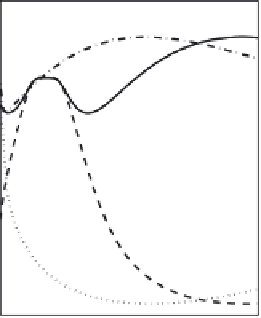Geoscience Reference
In-Depth Information
0.05
0.5
Day, E
0
= 0.5 V/m, γ = 1
Night, E
0
= 0.5 V/m, γ = 1
0
0.05
0
0.1
q
P
, right
q
H
, right
q
P
, left
q
H
, left
q
P
, right
q
H
, right
q
P
, left
q
H
, left
0.15
0.5
0.2
0.25
1
0.3
0.35
1.5
0.4
2
4
6
8
2
4
6
8
Frequency, MHz
Frequency, MHz
Fig. 13.7.
q
P
and
q
H
(see (13.19)) for the dayside ionosphere (left frame) and for
the nightside ionosphere (right frame) as functions of the pump frequency
assume that
ΓW
0
,
where
W
0
is the power radiated by the antenna in kW. It is seen from Fig.
13.3 that
δN
e
is roughly proportional to
T
e
:
E
∝
E
2
δN
e
/N
e
0
≈
T
e
≈
≈
ΓW
0
.
Therefore,
q
P
∼
Γ.
Substituting the latter relation into (13.20),
we find that the magnitude of the magnetic field disturbances does not de-
pend in this case on the antenna gain. However, for a strong field, nonlin-
ear effects result in the fact that a strong dependence of the antenna gain
develops.
Figure 13.7 presents the values of
q
P
and
q
H
in percents for the dayside
ionosphere (left frame) and for the nightside ionosphere (right frame) as func-
tions of the pump frequency. In the calculations 0
.
5 V/m.
The maximal magnetic disturbances
δb
in daytime are
Γ
and
q
H
∼
10
−
1
in nighttime for
E
0
=0
.
5 V/m. The same calculations for
E
0
= 5 V/m show
that
δb
10
−
3
∼
and
∼
10
−
3
in nighttime. The reduction of the
magnetic effect when passing from relatively low electric field to the stronger
field is a result of strong attenuation of the nonlinear pump wave in the low
ionosphere. Going from this region, the wave comes to the
E
-layer with low
intensity and cannot heat this region significantly. On the other hand, the
strong effect in night ionosphere in comparison with the dayside ionosphere
is explained by the absence of a
D
-layer in the night ionosphere where the
wave decays appreciably.
At middle latitudes, the magnitude of the background
S
q
variation is of
the order of 50 nT in daytime and 1 nT at night. Then the magnitudes of
the expected variations generated during the irradiation of the ionosphere
with a strong HF wave
10
−
4
∼
in daytime and
∼
(10
−
2
10
−
3
)nT in daytime and
10
−
1
nT in
∼
5
×
−
∼




























Search WWH ::

Custom Search